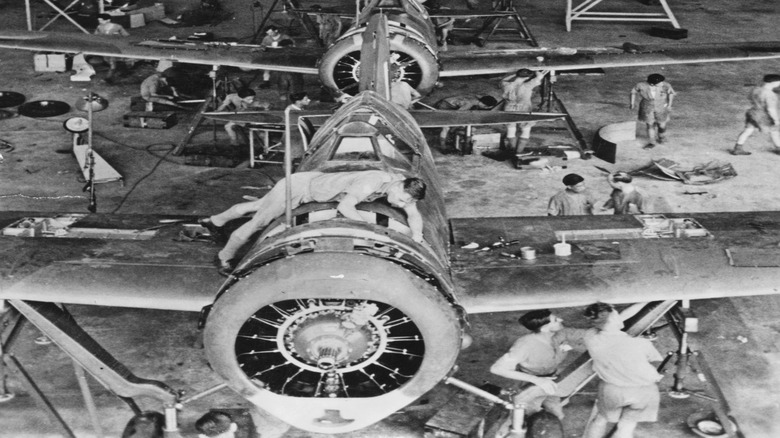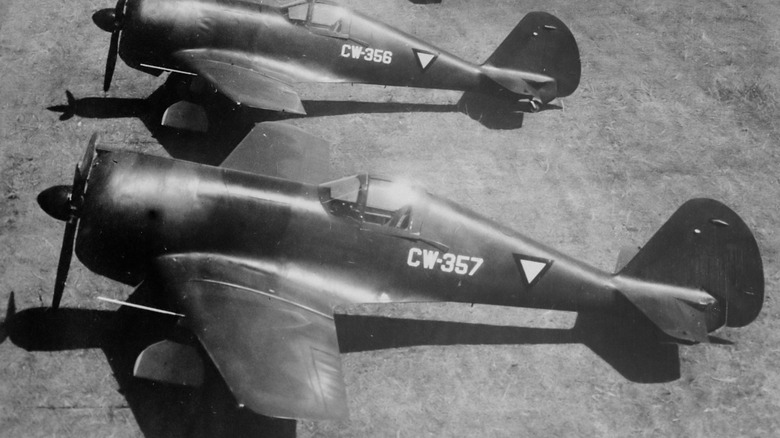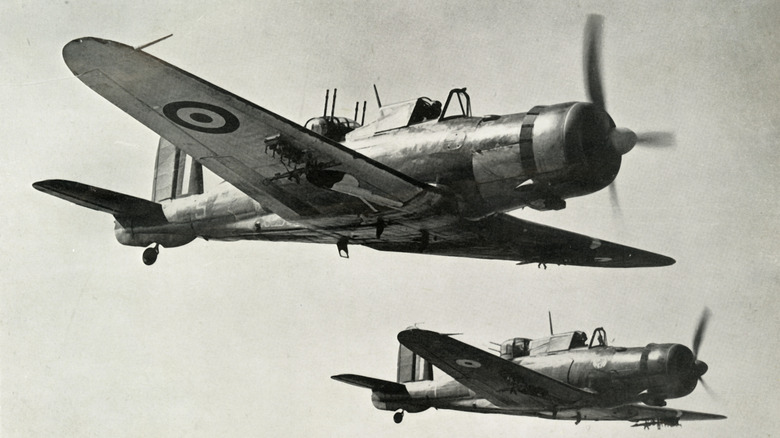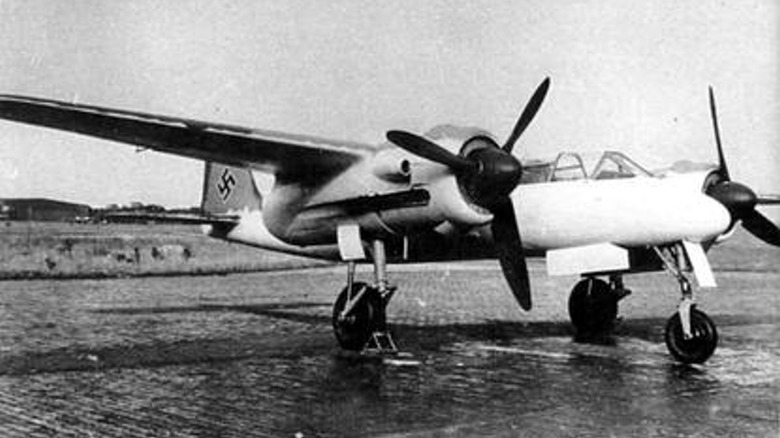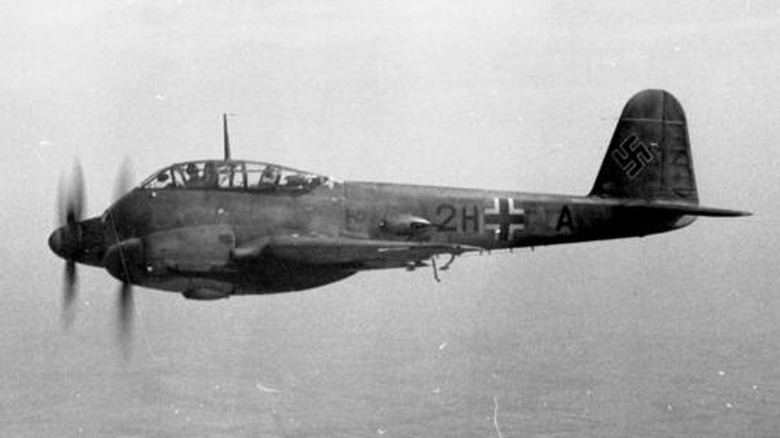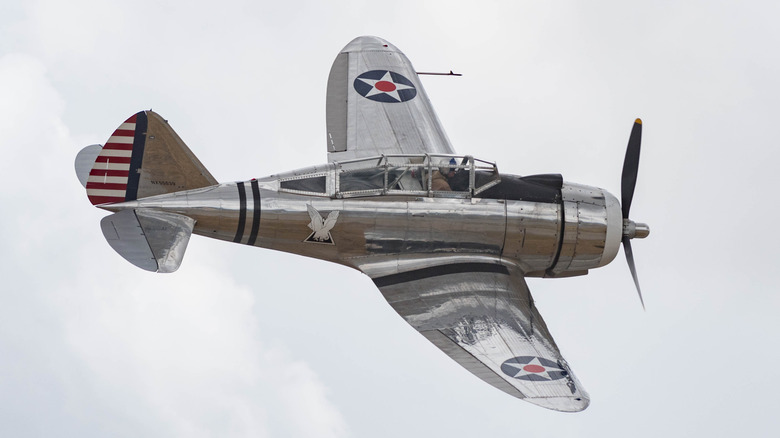5 Of The Worst Fighter Planes In World War 2
World War II saw a great deal of innovation in the area of fighter aircraft design and construction, as it was the conflict that gave birth to the jet fighter. More than that, multiple nations fielded a variety of fighters, bombers, cargo, and transport aircraft, though the fighters and the bombers get most of the attention. There were some spectacular fighter aircraft flying about the world's unfriendly skies throughout the conflict, many of which helped the Allies to victory over the Axis powers.
Still, not every WWII fighter plane can be as successful as Japan's Mitsubishi A6M "Zero," the North American P-51 Mustang, or the German Messerschmitt Bf 109. The unfortunate reality of airplane design is that some planes that flew during WWII were absolutely terrible machines. Whether they suffered from unforeseen issues during the design stage or they were rushed through production because the need demanded that happen, several fighter planes used on all sides of the conflict suffered from numerous problems.
There are a few that were so terribly designed and constructed that Dutch pilots called aircraft like the Brewster F2A Buffalo a "flying coffin" in comparison to Japan's more agile fighters. While most people know a bit about some of the aforementioned good fighters, history has a way of glossing over the bad ones. That's certainly true of some of the worst fighter planes produced during WWII, which don't get all the press they deserve nearly a century after the dust settled from the war. Still, these five aircraft were so utterly awful that they deserve to be mentioned long after their last successful, or more likely unsuccessful, flight.
Curtiss-Wright CW-21 Demon
In the years before the outbreak of World War II in Europe, the Curtiss-Wright Corporation got busy developing an interceptor for future operations. The company came up with the Curtiss-Wright Model 21, otherwise known as the CW-21 Demon. The primary design concept of the CW-21 was centered around its ability to climb to a high altitude quickly, eliminating the need for dogfighting while still serving as an attack aircraft against enemy bomber formations.
The aircraft was fitted with a Wright R-1820-G5 Cyclone engine capable of delivering 850 hp. This enabled the CW-21 to fly 314 mph and reach a service ceiling of 34,300 feet at a rate of 4,500 feet per minute. For its armament, the CW-21 sported two .50 caliber M2 Browning machine guns and two .30 caliber M1919 Browning machine guns, so on paper, the aircraft was more than a match for bomber formations, and it had the speed needed to avoid fighters.
Only 62 were made between 1939 and 1940 before the project was abandoned. Prototypes and early production aircraft were given to the Chinese, but they crashed. The aircraft was also made to be light and lacked needed protective armor, but chief among the problems was the fact that the CW-21 was almost impossible to land safely. No CW-21 survived the war, and there are no surviving models or prototypes at museums, making it a truly forgotten blip in aircraft development leading up to and throughout WWII.
[Featured image by Unknown via Wikimedia Commons | Cropped and scaled | Public Domain]
Blackburn B-25 Roc
The Blackburn B-25 Roc was a naval fighter that was first introduced to the Royal Navy in early 1939. The aircraft was designed to function as a dive bomber and fighter, so it was armed with four .303 caliber Browning machine guns with 2,400 rounds of ammunition and either a 250 lb. bomb or a 100 lb. anti-submarine bomb under each wing. The two-manned aircraft was powered by a Bristol Perseus XII engine that delivered 890 hp. Unfortunately, that wasn't enough power to reach a desirable speed, and the B-25 maxed out at 223 mph.
That's considerably slow for a fighter aircraft of the time; the P-51 Mustang's top speed was 437 mph, while the A6M2 Zero topped out at 316 mph. Despite the speed issue, the B-25 entered service, and a total of 136 were produced. Compared to similar aircraft, the B-25 was lightly armed and incapable of catching most enemy aircraft, so it failed to meet the needs of the Royal Navy. That said, the fighter did score a single victory in May 1940, when one successfully shot down a German Junkers Ju 88 bomber, which it hit from below.
Another issue with the B-25 was that it had a relatively small bombload, and while it could dive bomb targets with accuracy, it couldn't do a great deal of damage. Because of its ineffectiveness, the B-25 was pulled from combat duty and was relegated to missions like air-sea rescue, static anti-aircraft gun positions on the ground, and target-towing. These days, it's regarded as the U.K.'s worst WWII fighter, and there's little to disprove that assertion.
Focke-Wulf Ta-154 Moskito
German aircraft manufacturers worked tirelessly throughout the conflict to produce faster, better fighters. That was certainly the plan for the Focke-Wulf Ta-154 Moskito, which was designed to function as a speedy night fighter. Development began in 1942 and continued through much of the war before it was to enter into full production in 1944. Issues with supplies and interruptions to production via Allied bombing raids of manufacturing facilities ultimately doomed the Ta-154.
Only around 50 aircraft were completed before production was terminated in late 1944. The war was coming to an end in Europe, and the Ta-154 wasn't as capable as its designers hoped. The aircraft utilized two Junkers Jumo 213E engines capable of delivering a combined 3,500 hp. This enabled the aircraft to reach a maximum speed of 400 mph, which was fast for a fighter at that time. The Ta-154 also had a decent range of upwards of 1,160 miles, and it was well-armed.
The Ta-154 boasted two 20 mm MG 151/20 cannons and two 30 mm nose-mounted MK 108 cannons. While the Ta-154 showed promise, ultimately, it was an inability to source the needed adhesive, called Tego-Film, that doomed the aircraft. The Allies destroyed the only factory where it was produced, eliminating a vital component in the aircraft's mostly wood construction. The Ta-154 was incomparable to the British De Havilland DH 98 Mosquito it attempted to copy, and was relegated to pilot training with the few aircraft that were actually capable of flight.
[Featured image by Luftwaffe via Wikimedia Commons | Cropped and scaled | Fair Use]
Messerschmitt Me-210
The Messerschmitt Me-210 was developed as a replacement for the Bf-110, resulting in a heavy fighter capable of carrying out ground attacks or dogfights in the air. Production problems plagued the fighter's development, and it suffered from design issues related to the configuration of its wings and fuselage. This slowed production of the Me-210, but Messerschmitt managed to produce several for the Luftwaffe, beginning in 1942.
There were multiple variants of the Me-210, and combined, 352 were built for Germany, while Hungary completed 108 under license, though most German aircraft were incomplete and placed into storage. The Me-210 was a powerful aircraft equipped with two Daimler-Benz DB 605B engines, each capable of delivering 1,455 hp. This enabled the aircraft to reach speeds of 360 mph, a service ceiling of 29,200 feet, and a range of 1,130 miles. For armament, the Me-210 boasted two 20 mm MG 151/20 cannons, two 7.92 mm MG 17 machine guns, and two 13 mm MG 131 machine guns inside remotely operated turrets.
The Me-210 could also carry an assortment of bombs weighing up to 4,409 lbs. Unfortunately, the aircraft had terrible handling, resulting in numerous crashes. Additional problems included the remote turrets, which rarely worked, and the doors under the nose could fully destabilize the aircraft, resulting in crashes. There was also the problem of the landing gear suddenly collapsing. Ultimately, the aircraft was so poorly designed that it was removed from combat service, causing Willy Messerschmitt to stop designing in his own company.
[Featured image by Hönicke via Wikimedia Commons | Cropped and scaled | CC BY-SA 3.0 de]
Seversky P-35
The Seversky P-35 is an interesting aircraft, as it's the first flown by the U.S. Army Air Corps to feature retractable landing gear, an enclosed cockpit, and an entirely metal construction. These design choices were a leap forward in aviation construction, but unfortunately, the P-35 wasn't the best fighter produced by the U.S. in the lead-up to WWII. The P-35's development began years before the U.S. joined the fight, and it was introduced into the inventory in 1937.
While only 183 were produced, the P-35 remained in active service for years with the Swedish Air Force. The P-35 was the U.S. first proper modern fighter, but by the time the nation entered WWII, it was already outdated and overshadowed by better aircraft. The fighter boasted a Pratt & Whitney R-1830 engine capable of delivering 850 hp. This enabled the P-35 to reach a maximum speed of 280 mph, reach a ceiling of 30,600 feet, and fly up to 625 miles away from its base.
Additionally, the P-35 was armed with a .50 caliber and .30 caliber fuselage-mounted machine gun, as well as 320 lbs. of bombs. That all sounds good on paper, but compared to the aircraft the Japanese and Germans were flying at the time, the P-25 was slow, heavy, and poorly armed and armored. The U.S. didn't fly them for long, but the P-35 found a home in Sweden, Colombia, Ecuador, and the Philippines. Its design inspired the development of the far more successful P-47 Thunderbolt. Only one P-35 survived the war, and it's on display at the National Museum of the United States Air Force in Dayton, Ohio.
